Nothing lasts forever. Everything will face its end someday, but why today? The sea’s calm, the sun’s smiling, and life is good.
Why today? Why not. After all, you never know the intentions of the grim reaper, and this could be the day he has decided to take a swing at your outboard motor. That’s right. As you read this, your motor could be on the verge of an expensive breakdown, and you wouldn’t have a clue.
But your outboard doesn’t have to suffer an untimely demise. With the proper TLC, any motor can last almost indefinitely. And that’s only one of the lessons we learned during a visit to Outboard Recycle Parts and Marine (ORPM) in Semmes, Alabama. At this motor mortuary on the wrong side of the tracks near Mobile, busted engines arrive by the truckload every day. Hundreds of them are hung out to dry on open-air racks like sides of beef in a packing house. Eventually, each carcass is dissected and any useful parts are salvaged.
ORPM’s business is reincarnation-refurbishing thousands of dead powerheads and gearcases every year so they can fish, ski, and cruise again. So we decided to dig into the guts and gore lying around at ORPM to learn what you can do to spare your outboard from such a cruel fate.
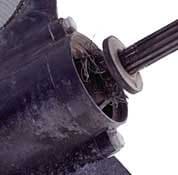
Outboard Autopsy
Case 1: Death By Garrote
How could 20-pound test fishing line sink a mighty outboard? Neglect. A stray piece of line snags the gap between the propeller and gearcase. It works deeper into the crevice, then begins coiling randomly around the shaft inside. A few thousand rpm later and the line is a tangled mess. Water and exhaust pressure force this intruder into contact with the lip seal. The subsequent abrasion destroys the seal, resulting in a total loss of lubricant. The gears and bearings inside grind themselves to smithereens.
This tragedy is easily avoided. ORPM’s owner Steve Chambless says, “Slipping the prop off the shaft once a month in salt water or annually in fresh water could reveal a snagged fishing line before it’s done its dirty work. But just as important, greasing the shaft periodically will keep corrosion from seizing the prop’s hub permanently onto the shaft. When that happens, the prop has to be separated from its hub with a puller, and the hub has to be removed with a chisel. That’s a $200 repair.”
A cursory inspection of the gearcase’s lubricant supply every third outing will divulge both discoloration (indicating water contamination) and leakage (no lube drips out when the drain screw is loosened). It’s the equivalent of checking your car engine’s dipstick every now and then.
Factory service procedures call for fresh gear lube in the fall to make sure that water contamination doesn’t freeze and damage the gearcase. To that sound advice, Chambless adds this sensible tip: “Those who live in cold climates should make sure their outboard is stored for the winter with the engine trimmed down. We occasionally see gearcases destroyed by freeze cracks merely because water couldn’t drain out.”
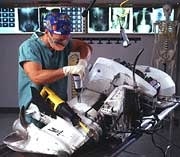
Outboard Autopsy
Case 2: Blunt Force Trauma
Running aground is a common boating experience. Usually we twist a prop blade or chunk the skeg and continue on our merry way. But in the extreme case, hitting submerged objects can cost $2,000 to $3,000 to replace the entire gearcase. Mark Payne, an ORPM lower-unit specialist with 20 years of experience, drags a few victims out of the trash to illustrate how. “Thirty years ago outboards had shear pins to protect driveline components from impacts,” he explains. “Then manufacturers decided that a rubber hub was a better means of protection, so shear pins went the way of the buggy whip. Rubber hubs work okay with aluminum props because the blades act as the weak link when you hit something. But everyone wants the superior performance offered by a stainless-steel prop, whose blades give hardly at all.”
The 150-hp Mercury XR6 gearcase we were shown provided vivid proof of what happens when you hit something with the throttles wide open. The rubber hub gave so much, the spines on the propeller shaft began twisting. The driveshaft was also bent by that high-speed impact.
The gearcase was damaged by running through oyster beds in shallow water. Chunks were knocked out of the skeg. Repeated impacts with oysters stripped off all the paint from the lower portions of the gearcase housing. The prop struck something so hard that debris flew and knocked a chunk out of the plate. The end finally came when a severe impact snapped a tooth off the pinion gear. The driveshaft sheared when that loose tooth wedged between other gear teeth.
“It’s rare for any outboard’s gear teeth to wear out. Running one every day for seven or eight years in a commercial application might result in excessive tooth wear, but I’ve never seen it in ordinary pleasurecraft use. On the other hand, it only takes one high-speed impact to fracture something in the driveline,” says Payne.
Unfortunately, no service procedure guards against collision with submerged objects. A light throttle and low speeds are your only hedge against expensive gearcase damage when it’s your turn to hit something.
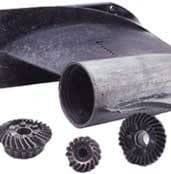
Outboard Autopsy
Case 3: Dog Day Afternoon
That crunching you hear when you select forward or reverse is a pair of dog clutches engaging. It’s the raised edges of the driving gear notching into contact with recesses machined into the face of the driven gear. As long as the shift linkage and idle speed are set to spec, everything is copacetic. But, as the 125-hp Mercury four-cylinder we selected for autopsy illustrates, problems can arise. Payne explains, “A failure can occur from a mistake as simple as decelerating from high speed and shifting into reverse too abruptly. But this set of dog clutches probably failed after repeated abuse. If the idle rpm is set too high, the dogs skip over one another before clicking into engagement. That rakes the square edges off the clutches and leaves metal chips circulating inside the gearcase. If the shift linkage is out of adjustment, a ratcheting effect can occur wherein the boat feels like it’s jumping momentarily out of gear.
“This owner let that minor problem persist with disastrous results. Metal knocked off the edges of the dog clutches jammed between the gear teeth and snapped some of them off. The jammed gears then fractured the aluminum bearing carrier that helps support the propeller shaft.”
The message: The first time you don’t experience a clean, quick clunk when shifting into forward or reverse, seek a knowledgeable diagnosis of the problem before it gets expensive.
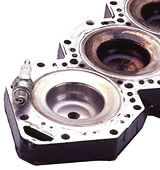
Outboard Autopsy
Case 4: Water Torture
Every outboard relies on a steady flow of water to keep its cool. But water in the wrong place at the wrong time can be hazardous to your outboard’s health. Notes Chambless, “Occasionally, we find owners who decide to help their motor run cooler by removing the thermostat. What they don’t realize is that their outboard is designed to run at a particular temperature.” Removing the thermostat permits excessive cooling flow, which will definitely lower the motor’s operating temperature. But this in turn upsets the dimensional stability of the working components so cold scuffing can occur. The pistons dig deep grooves in the cylinder bore surfaces and the motor grinds to a halt.
Chambless knows from personal experience what happens when water invades the wrong areas of the engine. “Last year I pumped my tanks full of water-contaminated fuel,” he says. There was so much dilution that water passed through the water/fuel separators and was ingested by my two 175-hp outboards. The boat ran fine until it sat for a while with water inside the engine. Then corrosion caused the piston rings to stick to the cylinder walls.”
Those ruined parts are long gone, so ORPM powerhead expert Tom Smith selects a V-6 head to illustrate these symptoms. “Water can enter via the fuel supply or from the cooling passages through a leaking seal. When it hits the combustion chamber, it scrubs away the carbon deposits until bright, clean metal shows. If the owner is lucky enough to discover condensation on a spark plug, that’s the warning bell that something major is amiss. But usually internal water leakage results in a major engine failure. The steam produced when the engine is running causes accelerated corrosion of machined ferrous-metal surfaces such as the cylinder bores.”
Lessons learned: Leave the thermostat in place, purchase fuel from trustworthy marinas, and inspect the spark plugs occasionally for evidence of moisture.
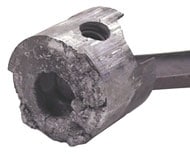
Outboard Autopsy
Case 5: Heat Stroke
The life blood of a two-stroke engine is a proper blend of fuel, oil, and air. Disrupt any of these three ingredients and you’re tempting fate. Chances are you’ll never hear the alarm bells-detonation’s death rattle, the scuffing of pistons in their bores, or the screech of metal on metal-before you’re dead in the water with a seized motor and $1,000 to $5,000 in repairs for a new powerhead. But a few easy maintenance moves can ward off this potential disaster.
The cause of a lean condition (too much air, not enough fuel and oil) can be as simple as a carburetor jet plugged by dirt or old fuel that’s turned to jelly. Pointing at a 90-hp three-cylinder Yamaha crankshaft with one blackened journal, Smith explains, “The middle carburetor failed to deliver an adequate supply of lubrication. It was probably left sitting over the winter without fuel conditioner. I think that a carburetor cleaning every spring is an excellent idea. Every outboard’s fuel filter and water pump should be changed at least every other year.”
Terminal lean-out will just as often trash your pistons. Mercury ORPM expert Ronny Gates selects two pistons with brown discoloration stains on the bottom, illustrating the early stages of failure. “This shows it was getting very hot very quickly, but just on the exhaust side. The dry look and golden-brown color is evidence of baked-on oil caused by the motor running much hotter than normal as a result of being run too lean.”
Aluminum pistons expand with temperature. When expansion consumes the running clearance between the piston’s side skirts and the cylinder wall, scuffing begins, followed rapidly by seizure.
Off-calibration fuel-air mixtures can raise combustion temperatures to the point of creating an incendiary bomb between the piston dome and cylinder head. The cause could be a cracked or pinched fuel line that results in inadequate fuel delivery-a lean mixture-at high rpm. Excessive air as a result of operating the motor with the air box removed, or a leaking carburetor base gasket also provokes a lean condition.
Fuel grade and ignition timing are other relevant factors. Smith explains, “Lean-out is actually a broad area for failures with a host of causes. If the timing is advanced too much or detonation as a result of insufficient fuel octane occurs, combustion can begin to eat holes through the centers of the pistons. Or it can be caused by too little fuel or oil and too much air. The symptoms run the gamut from mild detonation to terminal piston-to-cylinder-wall scuffing.” But the end result of lean-out is the same as the 175-hp OMC V-6 we are examining: scrap metal.
Terminal lean-out can be avoided by periodic induction-system service. Clean or change the filter screens with which every outboard is equipped. Have a mechanic you trust purge solid fuel residue from the carburetors each spring. Inspect fuel lines for leaks or cracking. Keep the ignition timing and oil injection settings on spec. Feed your outboard a steady diet of clean, high-octane gasoline.
A little thought and care are the keys to any outboard’s health and well-being. “Corrosion in salt-water applications usually limits the life of an outboard to 10 years,” says ORPM’s marketing manager Jason Brown, “But in fresh water, 25 years is common with regular maintenance, and we know there are thousands out there still running fine after 30 or 40 years of seasonal use.”









